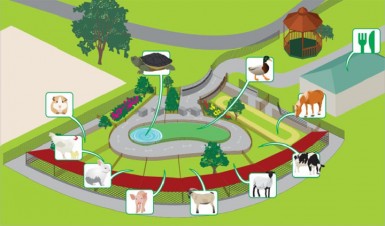Construction work for Guyana’s first Petting Zoo is to begin today at the Zoological Park following a contract signing yesterday at the Ministry of Natural Resources and the Environment.
The Petting Zoo is the newest part of the Guyana Zoological Park Master Plan, which seeks to transform the entire zoo into the major ecosystems of Guyana, bringing to life rainforests, savannahs and aquatic zones. It is intended to increase visits and generate revenue, which will in turn contribute to the modernization of the entire zoo. Alvin Chowramootoo has been contracted to build the facility and Minister Robert Persaud gave the cost to the government as $32 million and said it is expected to be completed in five months. “We hope that he [the contractor] would be aware of the urgency in the zoological park,” he said, before insisting that the contractor would move assiduously to complete

the Petting Zoo. “Then, in five months we can all meet there and discuss Guyana’s first Petting Zoo,” he added.
“The Zoo will be converted into the major ecosystems type of Guyana and basically we will be giving them a tour of Guyana in the zoo,” said Damian Fernandes, Com-missioner of the Protected Areas Commission.
The modernized zoological park, he said, would have walkthrough exhibits and archways that would give visitors the experience of walking into another world. A roughly circular design of the new facility, displayed on a screen, showed that it would be constructed next to the children’s playground with an all-weather walkway made out of paving stones. As a measure to combat flooding that currently plagues the zoological park, the proposed facility would be raised over three feet above the ground. The elevation is expected to improve drainage and sanitation.
The walkway would surround a central semi-aquatic enclosure, and a series of open enclosures which would enable human interaction with animals. The enclosures would be rotated with domesticated and wild animals. The commissioner noted the idea for a Petting Zoo would be well received, since visitors are always craving interaction with the animals, mostly by feeding them.
Last year, the ministry had announced the Three Parks Initiative—a project geared at rehabilitating the Botanical Gardens, the Zoological Park and the National Park. According to officials, the modernization of the zoological park would bring the facility up to international standards.
Fernandes said a Petting Zoo presents potential for repeat visits in the zoo, since it would be the first facility allowing structured interaction between people and animals in the zoo, which would eventually triple the facility’s income. “We want the man who comes to the zoo every three months to be forced to come back every weekend by the children to experience the petting zoo,” he stated, while explaining that it would take close to 33000 visitors per month to sustain the zoo.
He added the facility would also generate funds when visitors buy approved food to feed the animals and children’s parties are hosted. “Animal maintenance costs would also be minimal compared to wild species…,” he said.
A statement from the ministry said an opportunity for physical interaction with animals would be an effective method to educate individuals on issues like wildlife conservation, humane treatment of animals and an increased sense of appreciation and empathy for animals. “This will be important in the zoo’s effort to raise funds for the rehabilitation of large sections of the facility, reduce the amount of wild animals constantly being brought into the zoo,” the statement said.
“In essence the Petting Zoo is meant to be a living example of the Zoo’s renewed emphasis on education, enhanced visitor experience, animal welfare and higher standards,” the statement added.
Meanwhile, Persaud praised the initiative as visitor friendly, with a special emphasis to the service of children. He did, however, use the signing to plead for greater contributions from the private sector to rebuild the zoological park. Persaud expressed frustration with the sector’s feedback to the ministry’s fund raising exercise for the facility’s renovation.
“If you can’t assist us in the capital improvement, assist us in the maintenance of the zoo,” he said. Rehabilitation work on the park, he noted, is estimated at US$11 million.
Recently, the Mexico City Chapultepec Zoo had expressed an interest in the capacity care building of the zoo. Dr Enrique Mendoza-Salazar, an expert at the Mexican zoo, provided advice and training in the areas of animal nutrition, health and treatment regimes, education and awareness, enclosure design and cage enhancement.
The ministry had indicated that through the partnership local capacity would be strengthened by equipping the zoo’s personnel with new skills and techniques to better manage the facility and care for its animals. At the same time, technical support would reinforce the recently developed Zoo Master Plan, which outlines a long-term vision for the modernization of the Guyana Zoo.
The ministry and the Protected Areas Commission are continuously working with corporate and private sponsors to support the overhaul of a number of enclosures. “Consider it a puzzle…the Petting Zoo is the first major piece of that puzzle,” Fernandes said.





